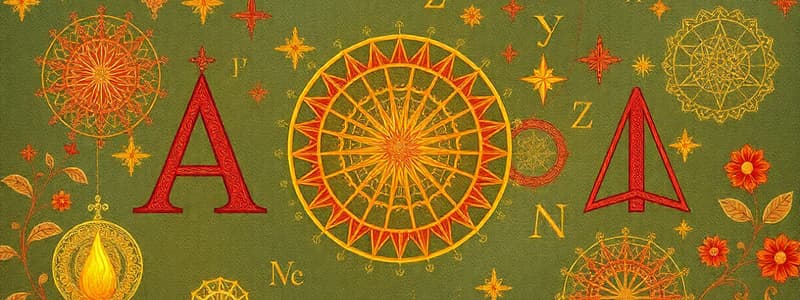Podcast
Questions and Answers
गणित में किस स्थूल सिद्धांत का संबंध अवकलन और इंटीग्रल से है?
गणित में किस स्थूल सिद्धांत का संबंध अवकलन और इंटीग्रल से है?
- संख्यात्मक सिद्धांत
- गणितीय सिद्धांत
- मूल सिद्धांत (correct)
- सरल सिद्धांत
निम्नलिखित में से कौन सा संख्या का प्रकार नहीं है?
निम्नलिखित में से कौन सा संख्या का प्रकार नहीं है?
- पूर्णांक संख्या
- गणितीय संख्या (correct)
- गैर-गणितीय संख्या (correct)
- ईमानदार संख्या (correct)
गणित का किस शाखा का अध्ययन संख्या के गुणों के बारे में होता है?
गणित का किस शाखा का अध्ययन संख्या के गुणों के बारे में होता है?
- संख्यात्मक सिद्धांत (correct)
- गणविज्ञान
- सांख्यिकी
- संभाव्यता
गणित का किस प्रयोग में भौतिकी के लिए लागू किया जाता है?
गणित का किस प्रयोग में भौतिकी के लिए लागू किया जाता है?
निम्नलिखित में से कौन सा संख्या का प्रकार अंक के साथ संबंधित नहीं है?
निम्नलिखित में से कौन सा संख्या का प्रकार अंक के साथ संबंधित नहीं है?
गणित का कौन सा विषय लगातार परिवर्तन के अध्ययन से संबंधित है?
गणित का कौन सा विषय लगातार परिवर्तन के अध्ययन से संबंधित है?
गणित में संख्याओं के गुणों का उपयोग किस प्रकार किया जाता है?
गणित में संख्याओं के गुणों का उपयोग किस प्रकार किया जाता है?
कौन सी गणितीय प्रक्रिया दो संख्याओं के बीच अंतर खोजने में प्रयोग होती है?
कौन सी गणितीय प्रक्रिया दो संख्याओं के बीच अंतर खोजने में प्रयोग होती है?
किस प्रकार के समीकरण सीधे रेखाओं को दर्शाते हैं?
किस प्रकार के समीकरण सीधे रेखाओं को दर्शाते हैं?
ज्यामिति में, क्षेत्रफल और परिधि का अध्ययन किस प्रकार के आकारों के लिए किया जाता है?
ज्यामिति में, क्षेत्रफल और परिधि का अध्ययन किस प्रकार के आकारों के लिए किया जाता है?
गणित में अनुपात और क्रम संबंध दिखाने के लिए किसका उपयोग किया जाता है?
गणित में अनुपात और क्रम संबंध दिखाने के लिए किसका उपयोग किया जाता है?
कैलकुलस में एक समीकरण की मैपिंग किसे दर्शाती है?
कैलकुलस में एक समीकरण की मैपिंग किसे दर्शाती है?
गणितीय तर्क का उपयोग किस चीज के निर्माण में किया जाता है?
गणितीय तर्क का उपयोग किस चीज के निर्माण में किया जाता है?
Flashcards
गणित (गणित)
गणित (गणित)
यह विषयों की एक विस्तृत श्रृंखला को शामिल करता है, जिसमें अंकगणित, बीजगणित, ज्यामिति, कलन और बहुत कुछ शामिल है।
अंकगणित (अंकगणित)
अंकगणित (अंकगणित)
गणित का आधार, जो मूल संख्या संक्रियाओं जैसे जोड़, घटाव, गुणा और भाग पर केंद्रित है।
बीजगणित (बीजगणित)
बीजगणित (बीजगणित)
अज्ञात मानों को दर्शाने के लिए चर, आमतौर पर अक्षरों द्वारा दर्शाए जाते हैं, और चर और संख्याओं के बीच संबंधों को दर्शाती है।
ज्यामिति (ज्यामिति)
ज्यामिति (ज्यामिति)
Signup and view all the flashcards
कलन (कलन)
कलन (कलन)
Signup and view all the flashcards
सेट सिद्धांत (सेट सिद्धांत)
सेट सिद्धांत (सेट सिद्धांत)
Signup and view all the flashcards
तर्क (तर्क)
तर्क (तर्क)
Signup and view all the flashcards
जोड़ (अतिरिक्त)
जोड़ (अतिरिक्त)
Signup and view all the flashcards
घटाव (घटाव)
घटाव (घटाव)
Signup and view all the flashcards
गुणा (गुणा)
गुणा (गुणा)
Signup and view all the flashcards
भाग (भाग)
भाग (भाग)
Signup and view all the flashcards
चर (चर)
चर (चर)
Signup and view all the flashcards
समीकरण (समीकरण)
समीकरण (समीकरण)
Signup and view all the flashcards
अवकलन और समाकलन का मूलभूत प्रमेय
अवकलन और समाकलन का मूलभूत प्रमेय
Signup and view all the flashcards
सीमा
सीमा
Signup and view all the flashcards
प्राकृतिक संख्याएँ
प्राकृतिक संख्याएँ
Signup and view all the flashcards
पूर्ण संख्याएँ
पूर्ण संख्याएँ
Signup and view all the flashcards
पूर्णांक
पूर्णांक
Signup and view all the flashcards
परिमेय संख्याएँ
परिमेय संख्याएँ
Signup and view all the flashcards
अपरिमेय संख्याएँ
अपरिमेय संख्याएँ
Signup and view all the flashcards
वास्तविक संख्याएँ
वास्तविक संख्याएँ
Signup and view all the flashcards
संख्या सिद्धांत
संख्या सिद्धांत
Signup and view all the flashcards
संयोजन गणित
संयोजन गणित
Signup and view all the flashcards
प्रायिकता
प्रायिकता
Signup and view all the flashcards
सांख्यिकी
सांख्यिकी
Signup and view all the flashcards
गणित का अनुप्रयोग
गणित का अनुप्रयोग
Signup and view all the flashcards
Study Notes
Fundamental Concepts
- Mathematics encompasses a vast array of subjects, including arithmetic, algebra, geometry, calculus, and more.
- Arithmetic deals with basic operations like addition, subtraction, multiplication, and division.
- Algebra introduces variables and equations, allowing for more complex problem-solving.
- Geometry studies shapes, sizes, and spatial relationships.
- Calculus deals with continuous change and is essential in fields like physics and engineering.
- Set theory defines sets and their relationships, which is crucial to many branches of mathematics.
- Logic is used to construct sound arguments and proofs in all branches of mathematics.
Arithmetic
- Arithmetic is the foundation of mathematics, focusing on basic number operations.
- Addition involves combining two or more numbers.
- Subtraction involves finding the difference between two numbers.
- Multiplication is repeated addition.
- Division is the inverse of multiplication, finding how many times one number goes into another.
- Properties of numbers, like commutative, associative, and distributive, significantly simplify calculations.
Algebra
- Variables, typically represented by letters, are used to represent unknown values.
- Equations represent relationships between variables and numbers.
- Solving equations involves isolating the variable to determine its value.
- Inequalities show relative order relationships, such as greater than or less than.
- Polynomials are expressions consisting of variables and coefficients.
- Linear equations represent straight lines on a graph.
- Quadratic equations represent curves, often parabolas.
Geometry
- Geometry studies shapes and their properties.
- Basic shapes include points, lines, angles, triangles, and circles.
- Concepts like area and perimeter help quantify space and shapes.
- Volume is a measure of the space inside a three-dimensional object.
- Transformations, including rotations, reflections, and translations, describe movements of shapes.
- Spatial reasoning is critical to understanding geometric concepts.
Calculus
- Calculus deals with continuous change, allowing a deeper understanding of functions and their behavior.
- Differentiation helps find rates of change, or slopes of tangents.
- Integration is the reverse of differentiation and helps find areas under curves.
- Derivatives are essential for modeling physical phenomena, such as velocity and acceleration.
- Fundamental Theorem of Calculus connects differentiation and integration.
- Limits are a crucial concept in calculus, defining the behavior of functions as values approach certain points.
Types of Numbers
- Natural numbers (1, 2, 3, ...) are used for counting.
- Whole numbers (0, 1, 2, 3, ...) include zero.
- Integers (..., -2, -1, 0, 1, 2, ...) include negative numbers.
- Rational numbers are numbers that can be expressed as a fraction.
- Irrational numbers cannot be expressed as a fraction; examples include √2 and π.
- Real numbers encompass both rational and irrational numbers.
- Complex numbers include imaginary units.
Branches of Mathematics
- Number theory studies properties of numbers.
- Combinatorics deals with arrangements and combinations.
- Probability studies the likelihood of events.
- Statistics analyzes data and draws inferences.
Applications of Mathematics
- Mathematics is used in various fields, including physics, engineering, computer science, and economics.
- Mathematical models describe real-world phenomena.
- Problem-solving skills honed through mathematics are essential for success in many fields.
- Mathematical concepts provide a framework for understanding the world quantitatively.
- Data analytics often uses mathematical methods and statistical techniques.
Studying That Suits You
Use AI to generate personalized quizzes and flashcards to suit your learning preferences.




